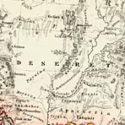Puerto Rico may not see a vote on the current statehood bill before the end of the year. A new bill will have to be introduced. “It is not uncommon,” says the NAACP, “for a bill to be reintroduced in four or five different Congresses (over a period of 8-10 years) before any action is taken on it. “This happened to many of the 32 territories that have become states. So far, no territory that requested statehood has ever actually been turned down. All have become states. But most have had lots of statehood bills introduced before they succeeded.
Still, there have been movements to create states which failed.
Sequoyah
The state of Sequoyah was proposed in 1905. It was part of Indian Territory, and had counties for a variety of Native American tribes. Each tribe would govern itself in its traditional way.
The leaders of the movement wrote up a constitution, planned the county divisions, and held a referendum. Up till that time, most of the Native Americans in Indian Territory had been opposed to statehood. Indian Territory had been all of what is now Oklahoma.
Toward the end of the 19th century, a section of Indian Territory became the Oklahoma territory. This part of the territory was opened to settlement by people from states. Native American leaders saw the powerless position of a territory and decided to go for statehood.
Statehood bills for Sequoyah were introduced in Congress, but they failed. President Teddy Roosevelt proposed uniting Sequoyah and Oklahoma to create a single state within the former borders of the Indian Territory. Territories often were combined or separated into multiple states, and borders often were changed.
The leaders of the Sequoyah Convention took leadership positions in the Oklahoma Convention, and the Oklahoma Constitution was based on the Sequoyah Constitution.
Nickajack
The state of Nickajack was proposed during the Civil War. A number of Southern states had flat delta areas where slave owners grew cotton, and hilly or mountainous areas where subsistence farmers lived, usually with few or no slaves. In Tennessee and Alabama, the mountaineers got together and decided that they wouldn’t secede from the Union. The war over slavery wasn’t their fight, and they didn’t want to be involved.
They decided to form a new state and call it Nickajack. The U.S. Constitution says that a state can’t be made from another state without the permission of the original state or states.
Tennessee and Alabama did not agree to the formation of Nickajack. In fact, they sent soldiers to occupy the area, and the residents never got to make their case to Congress.
Deseret
The Church of the Latter Day Saints proposed a state they wanted to call Deseret. It was enormous, including present-day Utah and much of the land which is now in surrounding states.
While the population wasn’t that big, Congress could see that such a large space could eventually have a lot more power than the average state. They rejected the idea of Deseret and established the Territory of Utah instead.
It took Utah a long time to become a state. Throughout the decades of work toward statehood for Utah, the church leaders continued trying to get Deseret admitted as a state.
Utah, rather than Deseret, became a state.
Puerto Rico?
Sequoyah was part of a territory. Deseret was more than a territory. Nickajack was part of two states. None of these failed states was actually a territory. No territory that has requested statehood has ever been turned down, though many have had to propose a lot of admission bills before they succeeded.
Puerto Rico is a territory. There have been statehood bills for Puerto Rico’s admission before now, and there will probably be more to come. There will eventually be statehood for Puerto Rico.
The ball is in Congress’s court. Tell your representatives that you want statehood for Puerto Rico.








2 Responses
It’s time for the territory of Puerto Rico to become state of USA. We demand equality.
What a lie!